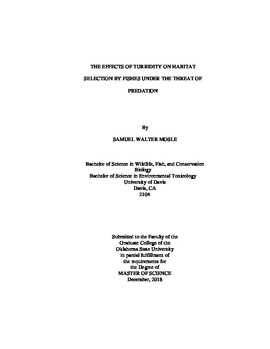| dc.description.abstract | Previous literature indicates Bluegill (Lepomis macrochirus) sacrifice optimal foraging behavior for refuge in dense vegetation while under the threat of predation, resulting in reduced growth rates. The majority of these studies were performed in clear water, which is uncommon under typical field conditions, especially under increasing anthropogenic disturbances. I investigated the effects of turbidity on habitat use by Bluegill under the threat of predation in the laboratory, followed by a corresponding field study. Laboratory trials were conducted in 6.5-m diameter tanks with artificial vegetation on one side and open water on the other. Bluegill and Largemouth Bass (Micropterus salmoides; a common predator of Bluegill) were given 18 hours to interact at one of five turbidity levels (0, 5, 10, 30, or 50 Nephelometric Turbidity Units [NTU]), after which a divider was dropped, allowing us to quantify the number of fish on the vegetated and open-water side of each tank. At all turbidity levels above 0 NTU, significantly fewer Bluegill were found on the vegetated side of the tank. However, vegetated habitat was always preferred to open water habitat, regardless of turbidity. In the field, pop nets were used to sample artificial vegetation in the spring of 2018 at Sooner Lake, Stillwater, Oklahoma, USA. Unfortunately, water of the field study was never turbid enough to test the results of the corresponding laboratory study, and no clear trends relating turbidity to the number of fish captured were observed. However, results from the laboratory experiment indicate vegetation manipulation and establishment efforts designed to provide juvenile fish refuge, and to provide fishing opportunities, may be useful for management in systems with turbidities as high as 50 NTU. Habitat additions may be more useful in clear systems, given Bluegill may not use vegetation as a refuge as frequently as when predated under higher turbidities. | |
